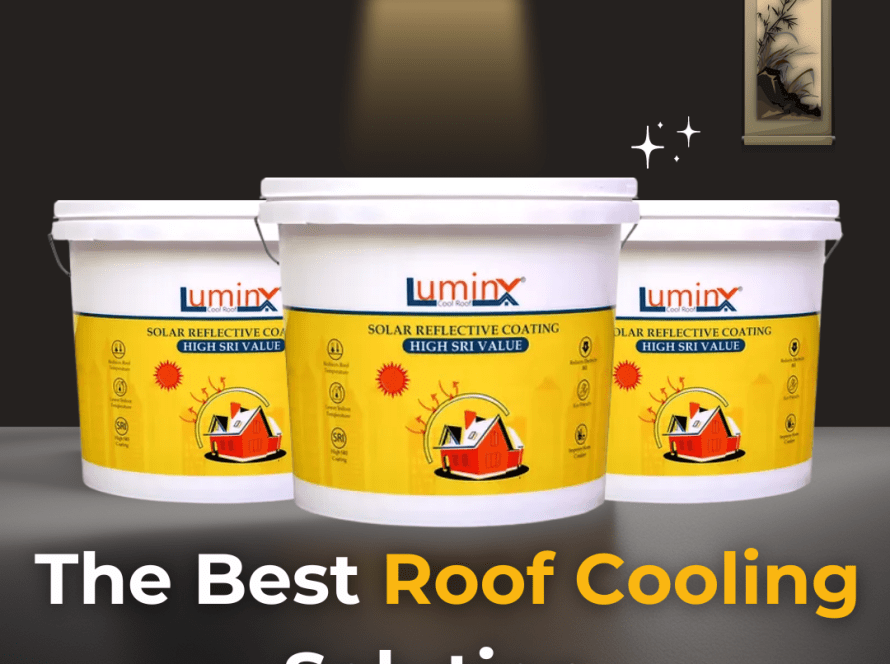Roof coatings have become an unrecognized hero in an expanding property market where homeowners want to protect and improve their assets more than ever. Knowing the many Terrace cooling paint options, their materials, and other considerations when selecting the best one can make the difference between a long-lasting investment and an expensive error for a homeowner or property manager.
Cool paint for roof is made of unique, often white, light-reflecting pigments. It is considered a highly thick cooling paint that shields the roof surface from water, chemical damage, and UV radiation. High solar reflectance and heat emittance are further features of cool roof coatings. To help you understand cool roof coatings better, we have listed the most common types, how to install them, their advantages and how to maintain them. Keep reading to know about the cool roofs.
Types of Cool Roofs
The energy efficiency of buildings is primarily dependent on their roofs. They significantly affect the building’s internal temperature and shield it from the outside elements. How much heat is absorbed and reflected by a cool roof paint can be influenced by its colour and materials, influencing the building’s energy usage and degree of comfort.
Two kinds of cool roofs, reflective and emissive, are intended to reflect sunlight and heat away from the building, lowering the amount of heat reflective paint absorbed into the structure. We will examine these two kinds of cool roofs in more detail.
- Reflective Cool Roofs
Heat reflective paint and sunshine away from the structure, lowering the heat absorption. Usually constructed of light-coloured materials with strong Solar reflective roof coating, including white or light grey, these roofs look great. A material’s solar reflectance measures its sunlight reflection. Reflective, cooling paint for roof reduces heat absorption, saving electricity and air conditioning. Because pavement and buildings absorb heat, urban heat island effects—when urban regions are noticeably warmer than nearby rural areas—are also lessened by these roofs. All wavelengths of light will be absorbed by a black or dark hue, raising the temperature. White or light colours will reflect all light wavelengths. Hence, heat is not produced from the light, and the temperature is not raised.
- Emissive Cool Roofs
Conversely, radiating heat away from the building is the purpose of emitting cool roofs. The materials used to build these roofs are usually highly thermal-emitting or able to radiate heat. Usually dark in colour, like black or dark grey, reflective, cool roofs are coated precisely to disperse Heat resistant paint to keep away from the structure. By returning the heat, the structure absorbs the atmosphere, emitting excellent roof cooling paint function. This lessens the amount of heat that is held inside the structure, which reduces the demand for air conditioning and energy bills. Emissive cool roofs are beneficial in hot, bright weather when the sun’s radiation can significantly increase building heat gain. You can use Summer seal paint, which provides glistening under the shining sun, creating a perfect finish on the patio.
The advantages of cool roofs
Cool roofs are those that deflect heat and sunshine away from structures, therefore lowering their total temperature. Putting in cool roofs has the following advantages:
- Saves on energy:
Cool roofs can cut air conditioning expenditures and energy consumption by up to 15% in the height of summer. To save more energy, you can use summer seal heat-reflective paint.
- Reduced urban heat island effect:
Cool roofs can lessen the heat island effect, which is the phenomenon whereby the absorption and re-emission of solar radiation cause metropolitan regions to have much higher temperatures than nearby rural ones. To reduce urban heat, you can try the new “Excel Cool Coating,” which reflects heat well and makes roofs and walls more energy efficient.
- Improved air quality:
Cool roofs trap less of the smog and other high-temperature pollutants, enhancing air quality. They might offer an affordable and long-lasting way to save energy use, improve building comfort, and lessen the detrimental effects of urban heat islands.
The Installation of a Cool Roof
Cool roofs are a growingly popular energy—and heat-saving solution for buildings. They reflect more sunlight than standard roofs, which can drastically reduce the energy required for cooling. If you consider giving your building a cool roof, here’s what to anticipate from the installation process.
- Examining the Current Roof:
Whether the current roof can handle the new system must be assessed before installing a cool roof. One aspect of the assessment is looking for leaks, damage, and required repairs.
- Selection of the Material:
Reflective coatings, single-ply membranes and tiles are just a few of the materials used to construct cool roofs. Many considerations influence the material selection, including the kind of roof, the temperature, and building regulations.
- Surface Preparation:
Following material selection, the roof surface needs to be ready for installation. Usually, this entails washing the surface and removing any debris or current coatings.
- Fitting:
The kind of material to be utilised determines how the installation is done. Coatings that reflect light are applied to the roof’s surface by spraying or rolling the material on. A single-ply membrane is placed over the roof and held with glue or nails. Reflective tiles are used instead of old ones on tile roofs.
- Maintenance of Cool Roofs:
Cool roofing is an outstanding way to lower building energy expenses and heat absorption. Like any other roofing material, it must be appropriately maintained to guarantee its durability and effectiveness.
- Fix damage quickly:
The cool roof needs to be fixed right away if any damage is to stop it from getting worse and creating more significant issues. To fix any roof damage, call in a qualified roofer.
- Maintain insulation:
A cool roof’s effectiveness depends critically on its insulation. Assure proper installation of the insulation and routinely check it for deterioration. Cool roofs need regular inspection, cleaning, and maintenance. These simple procedures will prolong your cool roof’s life and energy efficiency.
Conclusion
The Best Heat Resistant Paint for Terrace installation is essential for numerous reasons. Above all, it contributes to lessening the quantity of heat absorbed by a structure, resulting in cheaper energy bills and a more comfortable interior climate. Furthermore, Heat-Resistant High-Temperature Paints can reduce the urban heat island effect, which arises when cities and other metropolitan areas absorb and radiate heat, raising temperatures and energy demand. You can compare their heat-reflective properties, durability, and ease of application between Excel Cool Coat and Luminx. For the best practical cool roofing option, contact LuminX Cool Roof Coatings.




